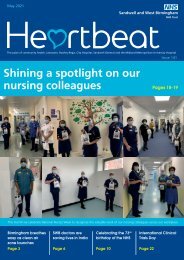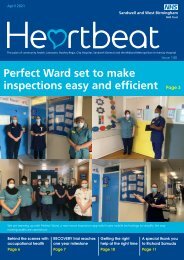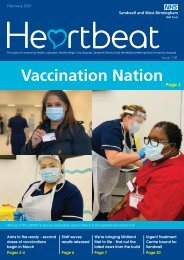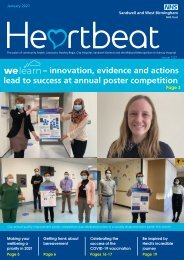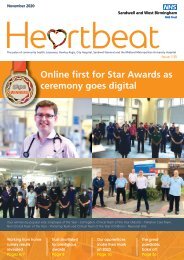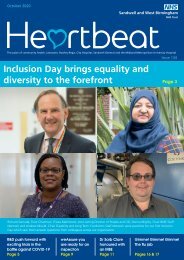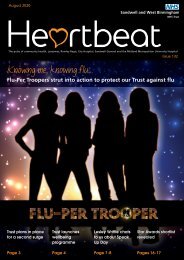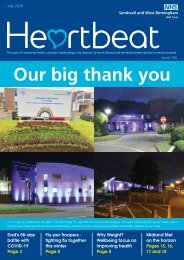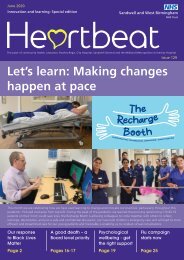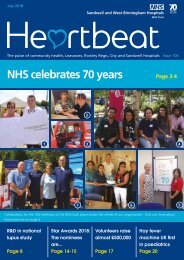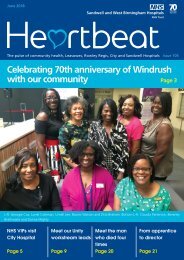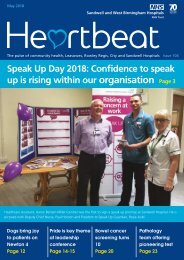Heartbeat March 2020
Create successful ePaper yourself
Turn your PDF publications into a flip-book with our unique Google optimized e-Paper software.
It’s not all about hospitals: Read about<br />
our community response to COVID-19<br />
Mel Roberts<br />
Group Director of<br />
Operations - Primary<br />
Care, Community<br />
and Therapies<br />
Most of the services in the community<br />
have had to think quickly about how they<br />
previously delivered care and what they<br />
need to do now. This has meant that<br />
some of the developments have needed to<br />
happen at pace. Community teams have<br />
been amazing in how quickly they have<br />
responded to these changes and developed<br />
their own ideas about how to provide care<br />
safely for our vulnerable patients. Services<br />
that were deemed more ‘routine’ or nonessential<br />
have either been scaled back or<br />
are being offered virtually via technology.<br />
Helen Hurst<br />
Director of<br />
Midwifery<br />
Babies will not stop arriving and unlike<br />
many other services, we cannot reschedule<br />
for a later date! Our service comes with a<br />
time specific package, an incubation period<br />
all of its own - 40 weeks approximately. So,<br />
how can we do things differently?<br />
Well, we have a developed a business<br />
continuity plan based on guidance from<br />
the Royal College of Obstetricians and<br />
Gynaecology that covers the impact on our<br />
available workforce. Our consultants in both<br />
obstetrics and neonates are undertaking<br />
clinics remotely where possible and we have<br />
aligned the pathways to reduce the need<br />
for multiple appointments. Our sonography<br />
team and obstetricians have developed a<br />
plan for screening of unborn babies, with<br />
reduced attendances. Our community<br />
Face to face activity has been reduced to<br />
minimise the infection control risk.<br />
Admission avoidance visits across the<br />
community continues to be a priority as<br />
does support to discharge patients from<br />
ward areas to ensure patient flow.<br />
There is no doubt that these are difficult<br />
times. Everyone is affected personally<br />
in a different way. There are anxieties,<br />
mostly around PPE and safety. Front line<br />
colleagues are worried because community<br />
work in patients’ own homes can be quite<br />
unknown until you get there. But there<br />
are also worries about family situations<br />
– elderly relatives, childcare and loved<br />
ones. Colleagues are coping remarkably<br />
well during what is a very uncertain time.<br />
There is a real sense that we are all in this<br />
together and a willingness to be flexible to<br />
do what needs to get us all through.<br />
teams are working from their bases on<br />
the whole, undertaking post-natal triaging<br />
and ensuring our most vulnerable families<br />
continue to have care in their homes, whilst<br />
we deliver other care via postnatal clinics.<br />
Inpatient (maternity and neonates) services<br />
have created hot zones and pathways<br />
to care for our women and babies with<br />
confirmed or suspected COVID-19. These<br />
areas are also used by our community staff,<br />
ensuring we are working together as one<br />
family.<br />
We are all anxious, worried and scared.<br />
But we are coming together united in<br />
one belief that we will persevere. We will<br />
ensure all our staff, women and families are<br />
supported during this unprecedented time<br />
and things that we put in place now will<br />
help to shape our service to come.<br />
As midwives our worry is that women will<br />
choose not to engage with us as they are<br />
scared and we see an increase in mortality<br />
and morbidity that we have worked so hard<br />
to reduce. Now, more than ever, we need to<br />
listen and advise.<br />
COVID-19<br />
Dottie Tipton<br />
Primary Care<br />
Liaison Manager<br />
There have been several changes to GP<br />
practices and how they work. We now<br />
have two ‘hot’ sites set up to manage<br />
symptomatic patients from practices across<br />
Sandwell and West Birmingham - Parsonage<br />
Street that previously housed the Walk in<br />
Centre and our own Lyndon Health Centre,<br />
and Aston Pride Health, which was a branch<br />
practice of Newtown Health Centre. All<br />
patients will be booked into appointments<br />
at these sites by their own GP Practice<br />
or by colleagues in NHS 111. Walk-in<br />
appointments are not available.<br />
Practices across Ladywood, Perry Barr and<br />
Sandwell have swiftly moved all services<br />
to a telephone triage model, much like<br />
our hospital outpatient clinics. For a few<br />
patients that will mean they will be invited<br />
into practice to be seen, if the consultation<br />
by phone or video is not enough.<br />
A home visiting service went live on 30<br />
<strong>March</strong> with an initial capacity of 10 slots<br />
per day and plans to expand. The service<br />
will take referrals from practices for patients<br />
who need a home visit but do not require<br />
district nurse input. Some practices have<br />
seen as much as 25 per cent reduction in<br />
available workforce and therefore practices<br />
are looking to reduce the number of sites<br />
that patients are seen face to face.<br />
It’s not all plain sailing, though and practices<br />
are worried about a number of things<br />
including whether they can have access<br />
to staff testing which we are looking to<br />
support.<br />
Cheryl Newton<br />
Group Director of<br />
Nursing - Women<br />
and Child Health<br />
Children and families in our communities<br />
still require support, even more so with the<br />
requirements of self-isolation and social<br />
distancing. The formal and informal support<br />
networks for families with newborn,<br />
toddlers or school age children are now<br />
significantly reduced which can mean<br />
people need more support from us, not less.<br />
We are using various technology to give<br />
them access to our community children’s<br />
nursing team when they need us.<br />
We recognise that some of our families with<br />
increased vulnerabilities may still need face<br />
to face contact and this is being maintained<br />
where possible. We have developed<br />
business continuity plans across all of the<br />
children’s community services. Our staff<br />
groups are adopting a flexible approach to<br />
providing on-going support to our children<br />
and families. We are utilising technology<br />
to provide virtual appointments where<br />
appropriate and offering face to face<br />
contacts for those children who<br />
require it.<br />
The impact of self- isolation and social<br />
distancing on the emotional health and<br />
well-being of our communities remains<br />
to be seen. Our main aim is to help<br />
families continue to reach out to our<br />
services for support during this time and<br />
we want to ensure that the child’s voice<br />
is still heard as families deal with the<br />
extraordinary circumstances we all find<br />
ourselves.<br />
7




